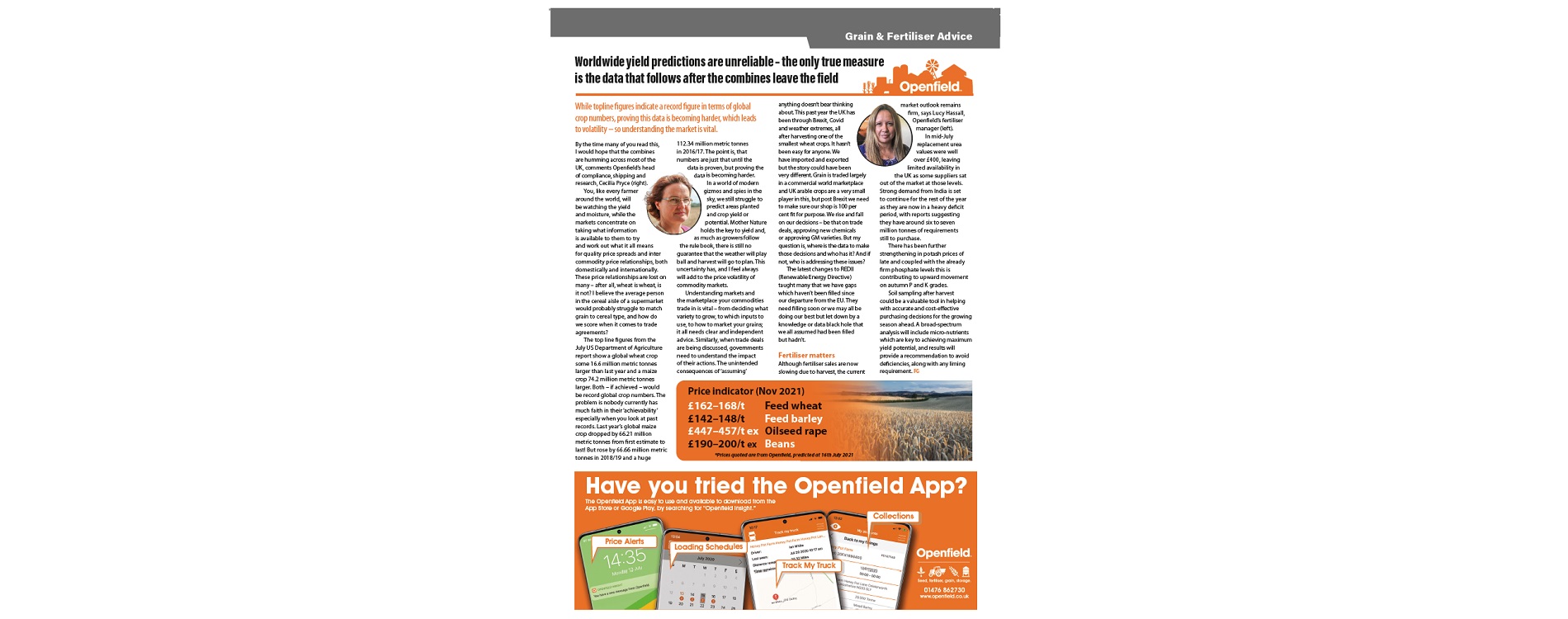Worldwide yield predictions are unreliable – the only true measure is the data that follows after the combines leave the field
While topline figures indicate a record figure in terms of global crop numbers, proving this data is becoming harder, which leads to volatility – so understanding the market is vital.
By the time many of you read this, I would hope that the combines are humming across most of the UK. You, like every farmer around the world, will be watching the yield and moisture, while the markets concentrate on taking what information is available to them to try and work out what it all means for quality price spreads and inter commodity price relationships, both domestically and internationally. These price relationships are lost on many – after all, wheat is wheat, is it not? I believe the average person in the cereal aisle of a supermarket would probably struggle to match grain to cereal type, and how do we score when it comes to trade agreements?
The top line figures from the July US Department of Agriculture report show a global wheat crop some 16.6 million metric tonnes larger than last year and a maize crop 74.2 million metric tonnes
larger. Both – if achieved – would be record global crop numbers. The problem is nobody currently has much faith in their ‘achievability’ especially when you look at past records. Last year’s global maize crop dropped by 66.21 million metric tonnes from first estimate to last! But rose by 66.66 million metric tonnes in 2018/19 and a huge 112.34 million metric tonnes in 2016/17. The point is, that numbers are just that until the data is proven, but proving the data is becoming harder.
In a world of modern gizmos and spies in the sky, we still struggle to predict areas planted and crop yield or potential. Mother Nature holds the key to yield and, as much as growers follow the rule book, there is still no guarantee that the weather will play ball and harvest will go to plan. This uncertainty has, and I feel always will add to the price volatility of commodity markets. Understanding markets and the marketplace your commodities trade in is vital – from deciding what variety to grow, to which inputs to use, to how to market your grains; it all needs clear and independent advice. Similarly, when trade deals are being discussed, governments need to understand the impact of their actions. The unintended consequences of ‘assuming’ anything doesn’t bear thinking about. This past year the UK has been through Brexit, Covid and weather extremes, all after harvesting one of the smallest wheat crops. It hasn’t been easy for anyone. We have imported and exported but the story could have been very different. Grain is traded largely in a commercial world marketplace and UK arable crops are a very small player in this, but post Brexit we need to make sure our shop is 100 per cent fit for purpose. We rise and fall on our decisions – be that on trade deals, approving new chemicals or approving GM varieties. But my question is, where is the data to make those decisions and who has it? And if not, who is addressing these issues? The latest changes to REDII (Renewable Energy Directive) taught many that we have gaps
which haven’t been filled since our departure from the EU. They need filling soon or we may all be doing our best but let down by a knowledge or data black hole that we all assumed had been filled but hadn’t.
Fertiliser matters
Although fertiliser sales are now slowing due to harvest, the current market outlook remains firm. In mid-July replacement urea values were well over £400, leaving limited availability in the UK as some suppliers sat out of the market at those levels. Strong demand from India is set to continue for the rest of the year as they are now in a heavy deficit period, with reports suggesting they have around six to seven million tonnes of requirements still to purchase.
There has been further strengthening in potash prices of late and coupled with the already firm phosphate levels this is contributing to upward movement on autumn P and K grades. Soil sampling after harvest could be a valuable tool in helping with accurate and cost-effective purchasing decisions for the growing season ahead. A broad-spectrum analysis will include micro-nutrients which are key to achieving maximum yield potential, and results will provide a recommendation to avoid deficiencies, along with any liming requirement.




